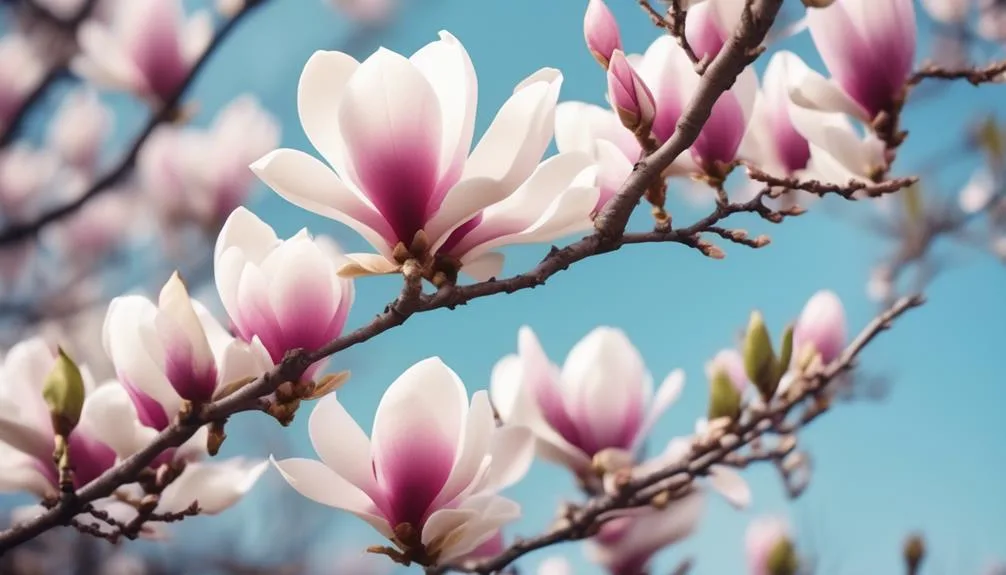Ever wondered why magnolia trees bloom in spring? It's not just a coincidence.
The timing of their stunning blossoms is influenced by environmental factors and their unique life cycle.
Understanding this relationship offers fascinating insights into the natural world and the beauty that surrounds us.
Magnolia Trees and Spring Blooming
As spring arrives, magnolia trees burst into a spectacular display of vibrant blossoms, marking the season with their breathtaking beauty.
The pollination process of magnolia trees is a fascinating spectacle to witness. Their large, showy flowers attract pollinators like beetles, flies, and bees with their sweet fragrance and nectar.
The flowering patterns of magnolia trees vary depending on the species, with some blooming early in the season and others later. The flowers can range in color from creamy white to deep pink or purple, adding a stunning pop of color to the landscape.
Magnolia trees have evolved to bloom in spring as it offers the ideal conditions for their pollination process, ensuring the continuation of their species.
Understanding the intricate relationship between magnolia trees and their spring blooming adds depth to the appreciation of their natural beauty.
Environmental Factors Influencing Magnolia Blooms
Influenced by various environmental factors, the blooming of magnolia trees is a wondrous phenomenon that reflects the intricate balance of nature's elements.
The pollination process is crucial for the stunning blossoms to appear. Magnolias rely on insects, particularly beetles, for pollination, and their bloom time is often synchronized with the emergence of these pollinators.
The soil quality also plays a pivotal role in influencing magnolia blooms. These trees thrive in well-drained, slightly acidic soils with good organic content. Adequate soil moisture and nutrients are essential for healthy growth and abundant flowering.
Factors such as temperature, humidity, and sunlight also impact the blooming of magnolia trees, highlighting the intricate relationship between these stunning plants and their environment.
Life Cycle of Magnolia Trees
The magnificent blooming of magnolia trees, intricately linked to environmental factors, marks the beginning of their captivating life cycle. Magnolia trees follow a distinctive life cycle, adapting to seasonal changes and showcasing remarkable growth. Below is a table that outlines the key stages in the life cycle of magnolia trees:
| Life Cycle Stage | Description |
|---|---|
| Seedling Stage | Germination and root growth |
| Sapling Stage | Development of trunk and branches |
| Maturation Stage | Flower and leaf production |
| Reproductive Stage | Seed formation and dispersal |
Magnolia tree growth is influenced by the transitioning seasons, with each stage playing a vital role in the tree's development and eventual blooming. Understanding the life cycle of magnolia trees enhances appreciation for their resilience and beauty.
Impact of Temperature on Magnolia Bloom
Understanding how temperature affects the bloom of magnolia trees is crucial for appreciating the delicate balance of nature's influence on their stunning display.
- Effect of Climate on Bloom
Warmer temperatures can cause magnolia buds to bloom earlier, while cooler temperatures can delay the bloom. Sudden frosts during the budding stage can even damage the flowers, leading to a reduced display of blooms.
Magnolia trees require a period of cold temperatures to bloom successfully, but extreme cold can also harm the flower buds, impacting the bloom for the current season.
The temperature plays a significant role in the different stages of magnolia flowering. Understanding these effects can provide insights into the timing and abundance of magnolia blooms, enhancing the appreciation of their natural beauty.
Importance of Spring for Magnolia Trees
Spring heralds the much-anticipated awakening of magnolia trees, as their branches burst forth with a profusion of delicate blossoms in a breathtaking display of natural beauty.
Spring is crucial for magnolia trees as it marks the end of their dormancy stage, initiating the flowering pattern and growth cycle. During winter, magnolia trees remain dormant, conserving energy and resources. However, as spring arrives, the rising temperatures and increased daylight trigger the trees to emerge from dormancy, kickstarting their growth cycle.
This period is vital for the pollination process, as the emergence of flowers attracts pollinators, such as bees and butterflies, facilitating the transfer of pollen for reproduction. Without the specific environmental cues provided by spring, the magnificent display of magnolia blossoms and the pollination process crucial for their survival wouldn't occur.
Conclusion
In spring, the blooming of magnolia trees is a remarkable result of environmental factors and temperature. These beautiful blooms bring joy and beauty to the world, reminding us of the wonder of nature in full bloom.
Take a moment to appreciate the stunning flowers and the marvels of the natural world.

My interest in trees started when I first saw the giant sequoias in Yosemite.
I was a teenager then, and I remember thinking, “I need to learn more about this.”
That moment stuck with me.
A few years later, I went on to study forestry at Michigan Tech.
Since graduating, I’ve worked in a mix of hands-on tree care and community education.
I’ve spent over ten years helping people understand how to plant, maintain, and protect the trees in their neighborhoods.
I don’t see trees as just part of the landscape.
They are living things that make a real difference in our daily lives.
